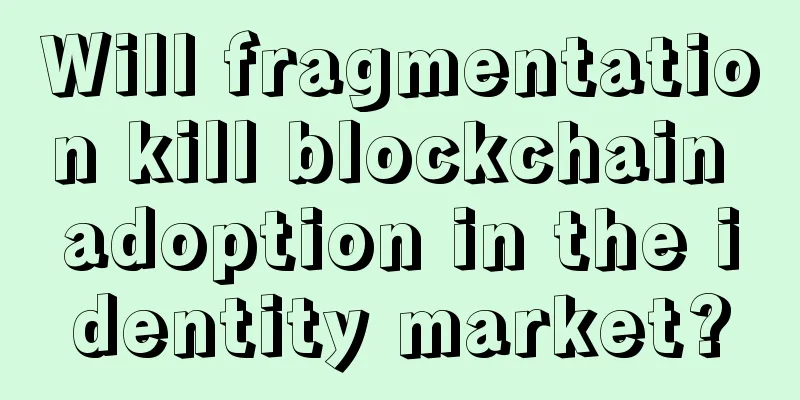Will fragmentation kill blockchain adoption in the identity market?

|
Blockchain identity recognition technology can ensure that users have full control over their identity information. At the same time, this technology can also make it easier for Internet users to log into their accounts seamlessly, bypassing complex login methods like a maze, unlock personal information, access services or trade digital assets. However, while various startups and technology companies have shown amazing innovation and creativity, I am concerned that the diversification of blockchain solutions will fragment the user base, making it more difficult to scale user applications. In its simplest form, blockchain can be used as a unique, irrefutable and unchangeable method of identification, because the “key” to identification is the identity itself. But what if different services you use require different identification keys? Imagine that you have 5 door keys. Depending on the date or the door you want to open, you need different keys. Or you have 5 houses in different parts of the world. You must find a way to distribute and manage the keys of these houses. Maybe you can manage it well, but it will definitely be tiring. In the Internet age, we have to use our brains or notes to remember various passwords, and we also have to worry about password attacks or forgetting passwords. So, I expect blockchain technology identity and access solutions to improve this situation. Solution FormationIn the blockchain space, a variety of solutions for identity, personal security, and access to data and services have emerged. These solutions use different approaches, some using new hardware, some from the software side, and some integrating with existing B2B solutions. It can be roughly divided into the following categories: hardware:Similar to hardware such as passports, government-issued IDs (such as driver's licenses), etc. In the blockchain field, some companies' solutions help with identity recognition by adding biometric data, such as startups ShoCard and Case. software:The closest example is OAuth-based identity: this is required when signing up for a website using a Facebook, Twitter or Google account. But blockchain solutions are exactly the opposite: first register your identity yourself, then link your social account. Companies like Netki, OneName, BitID and Identifi are working on this approach. Integrate existing solutions:The first two approaches are from the customer's perspective, while this approach integrates other available solutions. Some companies are interested in this approach, such as Cambridge Blockchain, Trunomi, uPort, Tradle and Ripple. Customer QuestionHowever, there are still some questions to be raised regarding the implementation and development of blockchain technology. For example, it is not yet clear what applications will advance these new forms of identity solutions. Facebook and Google both have their own special apps to push us towards usage. However, in the blockchain space, most identity verification solution providers are rushing to launch their own solutions before moving on to app development. These applications also present some key issues, including:
Business concernsFrom the business side, the question is how to provide these services without running afoul of regulators. Companies should ask themselves:
Original article: http://www.coindesk.com/fragment-blockchain-identity-market/ |
>>: The Economist: Fanatical is the eternal source
Recommend
"Father's Love is Deep" - Graphic Analysis of the Children's Line in the Palm of a Man
How to interpret the children line on a man’s pal...
Analysis of the face of a boy with a long face. Is his fate and personality good?
According to numerology research, a lot of inform...
The trend of the wisdom line in palmistry can tell whether you will be successful in your career
Work does not have to be just about making a livi...
Is the marriage life happy?
Is the marriage life happy? Statement: The pictur...
How will your future partner look like?
Many people often wonder what their future lover ...
People with single eyelids can also be very beautiful
Many girls hope to have double eyelids to make th...
Ethereum network difficulty reaches a record high of 5.74P
The current difficulty of the Ethereum network ha...
Minutes of the meeting on “Principles and Commercial Applications of Blockchain”
On April 19, 2016, Industrial Securities Shanghai...
A picture of a woman with a mole on her chin
There are moles on various parts of our body that...
Face recognition (eyes, nose, mouth)
Physiognomy is the art of predicting fortune or m...
What does a woman who brings good luck to her husband look like? Are you a woman who brings good luck to your husband?
People can know a person's fortune by looking...
A mole in the middle of a man's forehead will ruin his career fortune
How to interpret a mole in the middle of a man’s ...
Illustration of the facial features of the "川"-shaped eyebrows that indicate longevity and can lead to a long life
Is it good to have chuan-shaped eyebrows? A "...
Is it good to have a cross at the end of the love line? I am impulsive and easily attract villains.
How to read the love line on your hand? The love ...
Coin Zone Trends: Bitcoin Price Trends Based on Big Data This Week (2016-06-16)
The price of the currency is approaching 5000 for...









